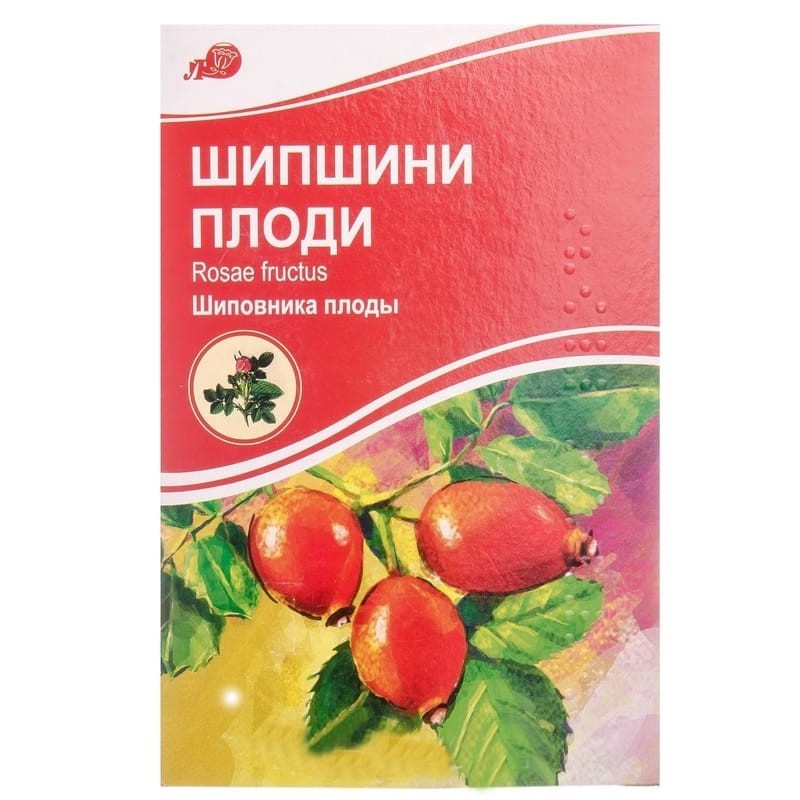



 Secure and encrypted payment processing
Secure and encrypted payment processing We ship to over 40 countries including the USA, UK, Europe, Australia and Japan
We ship to over 40 countries including the USA, UK, Europe, Australia and Japan Guaranteed refund or reship if you haven't received your order
Guaranteed refund or reship if you haven't received your orderActive ingredient: rose hips fruits (rosae fructus);
1 pack contains rose hips (rosae fructus) 100 g or 150 g.
Fruit.
The main physico-chemical properties: whole, cleansed of sepals and peduncles, false fruits of various shapes: from spherical, ovoid or oval to very elongated spindle-shaped; fruit length from 0.7 cm to 3 cm, diameter from 0.6 cm to 1.7 cm. At the top of the fruit there is a small round hole or a pentagonal platform. The fruits consist of a fleshy, with a rupture of a juicy receptacle (hypanthium) and numerous small nutlets that are in its cavity. The walls of dried fruits are hard, brittle, the outer surface is shiny, less matte, more or less wrinkled. In the middle, the fruits are densely expelled by long, very stiff thyroid hairs. Nuts are small, oblong, with weakly pronounced edges.
The color of the fruit is from orange-red to brownish-red, the nuts are light yellow, sometimes brownish. There is no smell. The taste is sour-sweet, slightly astringent.
Means acting on the metabolism and digestive system. code atx a16a x.
Biologically active substances of the fruits have an anti-sclerotic, anti-inflammatory effect; they activate enzyme systems and redox processes in the body, help eliminate vitamin C deficiency, normalize carbohydrate metabolism, enhance hormone synthesis and tissue regeneration, increase the bodys resistance to adverse environmental factors, increase bile secretion, increase diuresis, and reduce capillary fragility and permeability.
Bracing agent for acute and chronic infections, dystrophy, physical exertion. hemorrhagic diathesis; bleeding of various etiologies, an overdose of anticoagulants; acute and chronic liver diseases (chronic hepatitis, cholecystitis, cholangitis); diseases of the kidneys and bladder (nephritis, nephropathy in pregnant women) - as part of complex therapy.
Hypersensitivity to biologically active substances of the drug. thrombophlebitis and tendency to it, circulatory failure, endocarditis, decompensated diabetes mellitus, severe kidney disease, gallstone disease.
Unknown
After applying the broth, it is recommended to rinse the mouth with warm water or a weak soda solution to prevent damage to the tooth enamel.
The safety and effectiveness of drugs during pregnancy or lactation have not been studied, therefore, rose hips can be used only after consulting a doctor, when the expected benefit to the mother outweighs the potential risk to the fetus or child.
Does not affect.
1 tablespoon of the fruit is placed in an enameled bowl, pour 200 ml of hot boiled water, close the lid and insist on a boiling water bath for 15 minutes. cool at room temperature for 45-60 minutes, strain, squeeze the remainder into strained broth. bring the volume of the broth to 200 ml with boiled water. take warm 2 times a day after meals: adults and children from 14 years old - ½ cup, children 10-14 years old - 1/3 cup, 7-10 years old - 2 tablespoons, 3-7 years old - each 1 tablespoon, 1-3 years - 1 dessert spoon. Shake the broth before use.
The duration of the course of treatment is determined by the doctor individually, taking into account the nature, severity and characteristics of the course of the disease, the stability of the achieved therapeutic effect and tolerability of the drug.
The drug is used in children from 1 year.
Symptoms: the appearance or intensification of allergic reactions.
Treatment: symptomatic therapy.
Possible development of allergic reactions (including hyperemia, rash, itching, swelling of the skin).
2 years.
Store in the original packaging at a temperature not exceeding 25 ° C.
Keep out of the reach of children.
Store the prepared broth at a temperature from 8 ° C to 15 ° C for no more than 2 days.
100 g or 150 g in packs with an inner bag.
Over the counter.
Pao Lubnypharm.
Ukraine, 37500, Poltava region, Lubny, st. Barvinkova, 16.